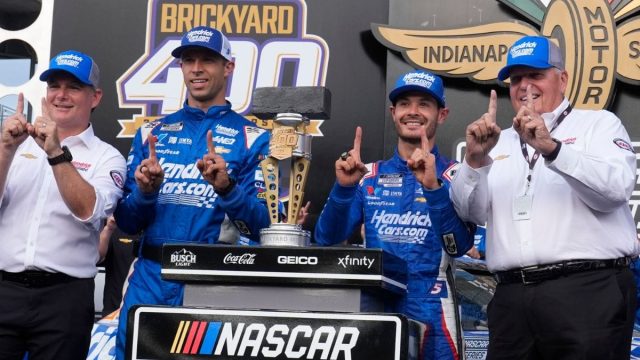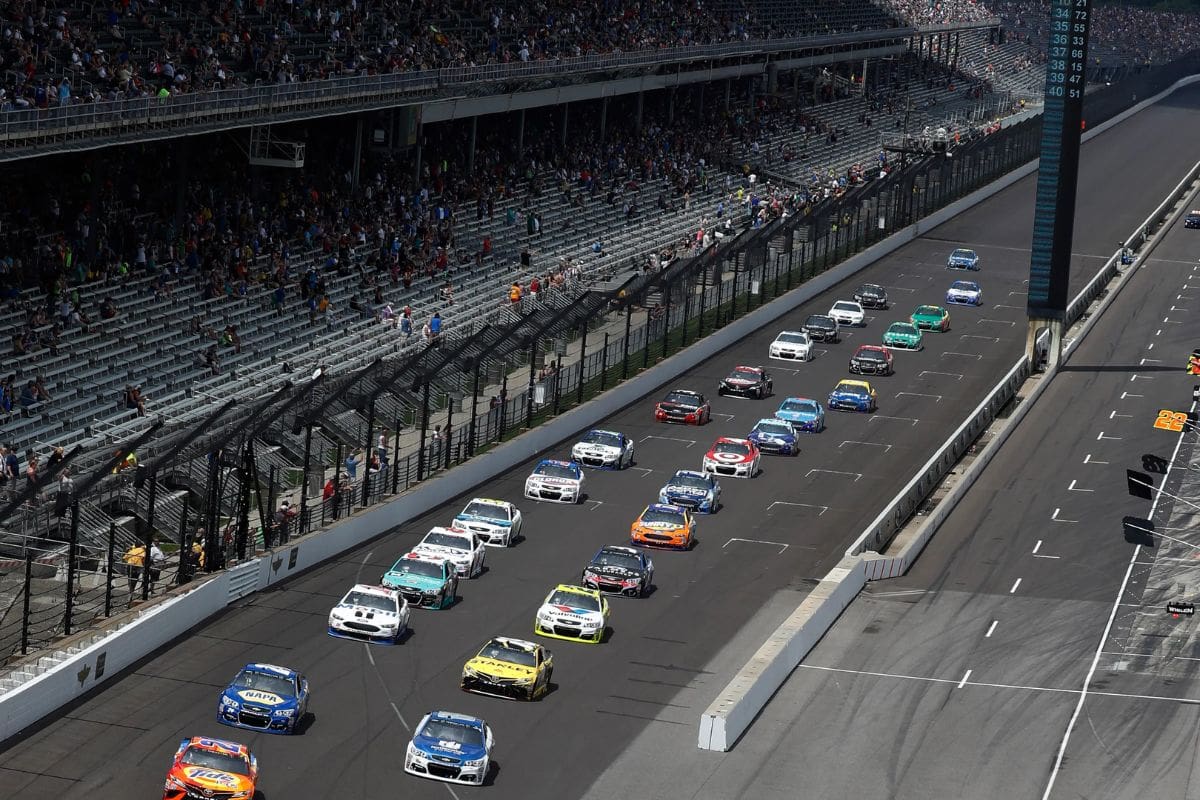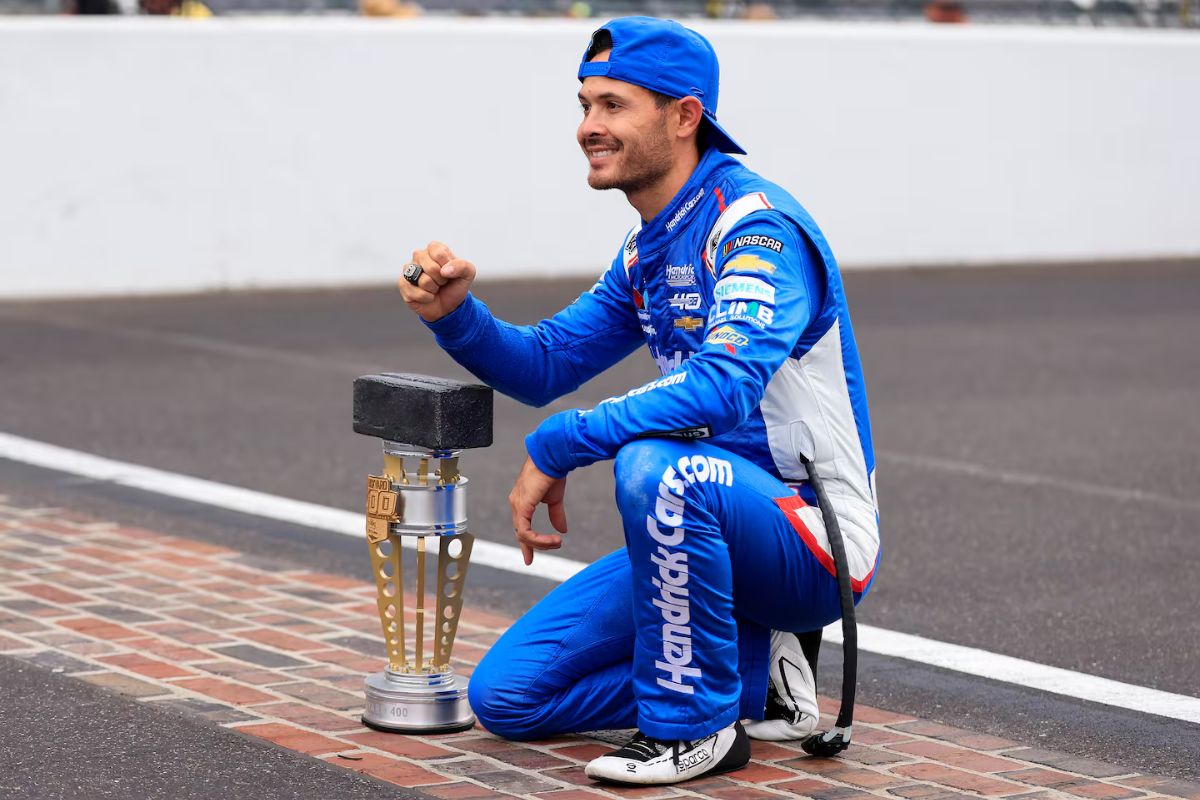Brickyard 400 Full Results: Kyle Larson claimed victory at the Brickyard 400, showing an impressive comeback from a 23rd-place start to secure the win at Indianapolis. Larson’s performance was marked by tactical racing, rapidly advancing to 10th within ten laps. His critical pass of Denny Hamlin propelled him into fifth place, highlighting his adaptability and racing skills. The race featured 18 lead changes and ten caution flags, emphasizing the competitive intensity throughout. As Larson celebrated, the implications for playoff positioning became clearer, particularly for contenders like Bubba Wallace.
Key Highlights
- Kyle Larson won the NASCAR race at the Brickyard 400, showing impressive skills and strategy.
- Larson advanced from 23rd position to claim victory, showing adaptability.
- Larson’s performance included critical passes and methodical progression through the field.
- The race lasted 3 hours, 29 minutes, with intense competition reflected in 18 lead changes.
Kyle Larson’s Remarkable Comeback
Despite the prevailing skepticism about overtaking at the Indianapolis Motor Speedway, Kyle Larson‘s remarkable comeback during the Brickyard 400 highlighted his exceptional driving abilities and tactical expertise, propelling him from 23rd to victory in a matter of laps. His ascent through the field was not merely a product of luck; it was a masterclass in racing strategy and skillful execution.
As the race unfolded, Larson faced a formidable challenge with only 30 laps remaining. The odds seemed stacked against him, yet he began to methodically carve through the competition. In just ten laps, he advanced from 23rd to 10th, a feat achieved through a combination of precision driving and keen situational awareness. Larson’s ability to read the track and identify ideal passing opportunities displayed his profound understanding of the sport.
With each lap, Larson continued to gain momentum, passing three more cars in a mere five laps to secure seventh place. The clock was ticking, but he remained focused, resulting in a critical pass of Denny Hamlin that positioned him in fifth. By the time he reached fourth place with ten laps remaining, Larson’s tenacity was noticeable.
Brickyard 400 Race Details
The Brickyard 400 featured an engrossing race characterized by a total duration of 3 hours, 29 minutes, and 9 seconds, highlighting the intense competition among drivers throughout the event. The race was not only a test of speed but also a display of tactical insight, particularly as it unfolded under challenging conditions marked by ten caution flags that spanned 34 laps.
The intricacies of the race can be further clarified through the following statistics, which underline the dynamic nature of the competition:
| Statistic | Value | Notes |
|---|---|---|
| Margin of Victory | Under Caution Seconds | A close finish, adding drama. |
| Caution Flags | 10 | Indicating frequent incidents. |
| Lead Changes | 18 among 13 drivers | A reflection of the competitive spirit. |
These figures depict the race’s significant stakes and the remarkable skill exhibited by the drivers. The 18 lead changes among 13 different competitors signify a relentless battle for supremacy, with each driver keen to seize the moment. The undercurrents of strategy during caution periods also played a pivotal role, as teams recalibrated their approaches to enhance performance.
Lap Leaders at Indianapolis
Throughout the Brickyard 400, distinct drivers displayed their skill, with Tyler Reddick leading the pack for the most laps, a display of his racing and skillful tactics. Reddick commanded the field early on, showing his expertise by leading for 40 laps over two stints, effectively managing his position and pace. His ability to maintain control set a competitive tone for the race.
Brad Keselowski and Denny Hamlin proved formidable challengers, with Keselowski leading for 35 laps and Hamlin for 21 laps across two periods. Keselowski’s tactical movements allowed him to assert his dominance at critical points, while Hamlin’s performance highlighted his experience and adeptness in steering through intense situations.
Bubba Wallace also made a notable impact, leading for 26 laps, which emphasized his rising capability within the NASCAR ranks. Meanwhile, John Hunter Nemechek and Kyle Busch each displayed their competitive edge, each leading for multiple laps, further enriching the race’s dynamic.
Kyle Larson, ultimately the race’s victor, led for 8 laps, indicating his consistent capacity to capitalize on opportunities. Other notable contributors included Ross Chastain, Noah Gragson, and Chase Elliott, each displaying flashes of brilliance, though their leads were limited.
Brickyard 400 Stage Results
In the Brickyard 400, the stage results revealed a competitive landscape, with the top ten drivers in Stage #1 showing a mix of established talent and emerging contenders. The leaderboards were dominated by notable names, with the No. 11 car claiming the top position, followed closely by the 5, 12, and 24 cars. This mix of veterans and beginners not only highlighted the depth of talent in the NASCAR field but also set the tone for an engaging race dynamic.
Stage #2 continued to reflect this competitive spirit, with new entrants making their mark. The 23 car emerged as a strong contender, finishing in the lead in this stage, while the No. 9 and 11 cars also maintained their positions within the top three. The persistence shown by these drivers is indicative of their tactics and adaptability, essential factors in a race that demands speed and tactical finesse.
Full Results of the Brickyard 400 Race
| Position | Driver | Car | Laps |
| 1 | Kyle Larson | Chevrolet | 167 |
| 2 | Tyler Reddick | Toyota | 167 |
| 3 | Ryan Blaney | Ford | 167 |
| 4 | Christopher Bell | Toyota | 167 |
| 5 | Bubba Wallace | Toyota | 167 |
| 6 | Todd Gilliland | Ford | 167 |
| 7 | Austin Cindric | Ford | 167 |
| 8 | Daniel Suarez | Chevrolet | 167 |
| 9 | Noah Gragson | Ford | 167 |
| 10 | Chase Elliott | Chevrolet | 167 |
| 11 | Ricky Stenhouse Jr. | Chevrolet | 167 |
| 12 | Carson Hocevar | Chevrolet | 167 |
| 13 | Austin Dillon | Chevrolet | 167 |
| 14 | Corey LaJoie | Chevrolet | 167 |
| 15 | Ross Chastain | Chevrolet | 167 |
| 16 | Michael McDowell | Ford | 167 |
| 17 | Zane Smith | Chevrolet | 167 |
| 18 | Cody Ware | Ford | 167 |
| 19 | Ty Dillon(i) | Chevrolet | 167 |
| 20 | Justin Haley | Ford | 167 |
| 21 | Brad Keselowski | Ford | 167 |
| 22 | Chris Buescher | Ford | 167 |
| 23 | Ty Gibbs | Toyota | 167 |
| 24 | Chase Briscoe | Ford | 167 |
| 25 | Kyle Busch | Chevrolet | 166 |
| 26 | Ryan Preece | Ford | 165 |
| 27 | Martin Truex Jr. | Toyota | 165 |
| 28 | Erik Jones | Toyota | 165 |
| 29 | John Hunter Nemechek | Toyota | 161 |
| 30 | Daniel Hemric | Chevrolet | 161 |
| 31 | Alex Bowman | Chevrolet | 161 |
| 32 | Denny Hamlin | Toyota | 161 |
| 33 | Jimmie Johnson | Toyota | 110 |
| 34 | Joey Logano | Ford | 109 |
| 35 | Josh Berry | Ford | 104 |
| 36 | Harrison Burton | Ford | 74 |
| 37 | AJ Allmendinger(i) | Chevrolet | 74 |
| 38 | William Byron | Chevrolet | 73 |
| 39 | BJ McLeod(i) | Ford | 15 |
NASCAR Playoffs
As the regular season approaches its endpoint, the point battle between Bubba Wallace and Ross Chastain intensifies, highlighting the critical nature of each race in determining the final playoff positions.
Following the Brickyard 400, Wallace’s impressive fifth-place finish has not only strengthened his confidence but also narrowed the point differential as he seeks to secure a spot in the playoffs. Meanwhile, Chastain’s 15th-place finish leaves him precariously positioned, with only a seven-point margin separating him from the cutline.
With just four races left in the regular season, the stakes could not be higher. Chastain must utilize his experience and skill to reinforce his standing, while Wallace must build on his momentum to close the gap. The psychological tension is noticeable, as both drivers are aware that every position gained or lost could be the difference between playoff competition and early elimination.
News in Brief: Brickyard 400 Full Results
Kyle Larson’s remarkable performance at the Indianapolis Motor Speedway emphasizes his resilience and skill within NASCAR. The race displayed tactical lap management and effective teamwork, contributing to a decisive victory.
With notable playoff implications, Larson’s success not only strengthens his standings but also highlights the evolving dynamics of the season. Such a comeback serves as proof of the unpredictable nature of motorsports, enchanting fans and analysts as the championship race continues to unfold.
ALSO READ: Ryan Blaney’s Silence on Kyle Larson Incident – What Happened?



